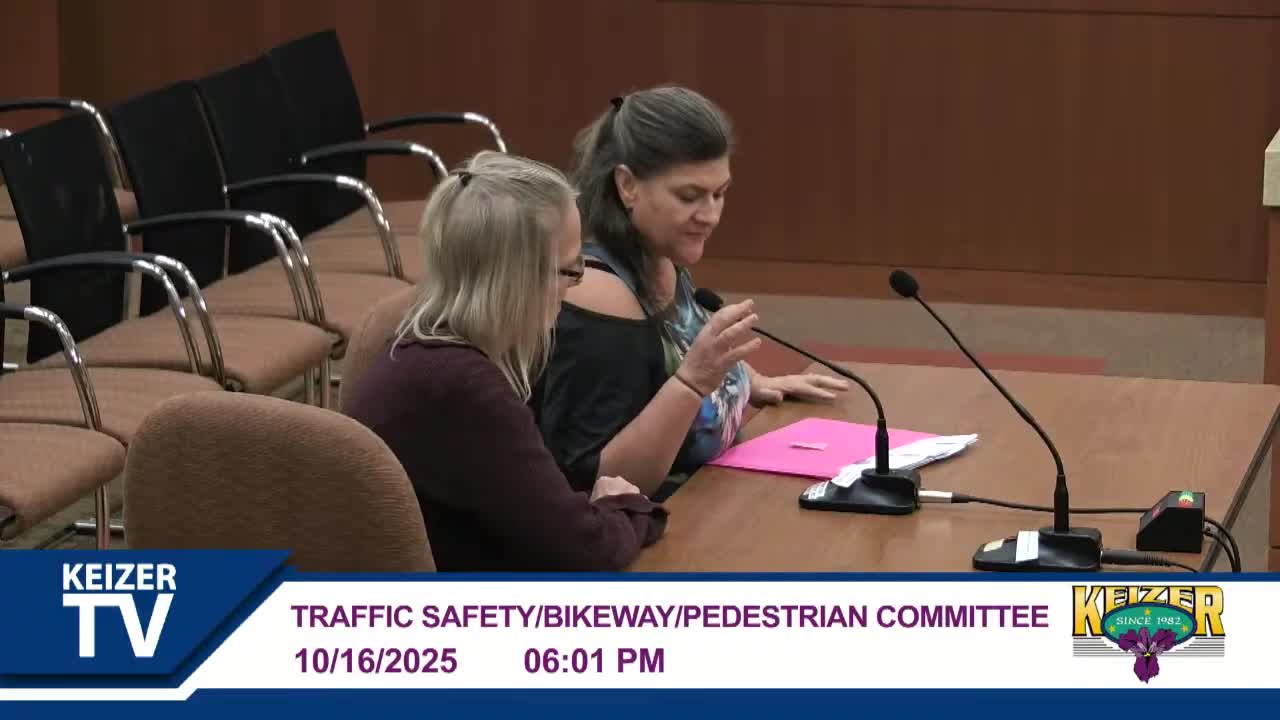Residents press Keizer committee on speeding, bike-lane hazards and ODOT path maintenance
October 17, 2025 | Keizer, Marion County, Oregon
This article was created by AI summarizing key points discussed. AI makes mistakes, so for full details and context, please refer to the video of the full meeting. Please report any errors so we can fix them. Report an error »

Several residents used the Keizer Traffic Safety, Bikeways and Pedestrian Committee’s Oct. 16 appearance-of-interested-citizens period to raise safety concerns at specific local locations, including an intersection near Mambran and Dorman, school-area speeding on Dearborn near Kennedy, and bike‑lane conflicts on Chemawa approaching Lock Haven and Keizer Station.
Tammy Kunz, representing the Greater Northeast Keizer Neighborhood Association, said she submitted nine neighborhood traffic management plan requests and that one application — a broad submission covering trees, parking, sidewalks, speeding and sight‑line hazards at the Mambran/Dorman/Brooks intersection — was returned as not meeting the plan’s criteria. Kunz asked how concerns that don’t fit the neighborhood plan process should be handled; staff and police said some requests have been handled by Public Works outside the neighborhood plan process when immediate attention was required.
Keizer police officer Officer Powell said the department had concentrated speed enforcement on Dearborn during a recent grant year and that a speed‑display trailer had been deployed on Dearborn North for more than a month. Powell also told the committee the city has two mobile speed‑display trailers; one is currently in use on Dearborn North and the other needs battery maintenance. “We have 2 of them already,” Powell said during the meeting.
On Chemawa at the Lock Haven approach, parents and neighborhood members said bicyclists traveling to Keizer Station have been bumped by cars and described potholes and debris in the bike lane. One resident said a teenage bicyclist was struck and rode home injured rather than report the incident; committee members noted that unreported incidents do not appear in official crash statistics, which complicates data‑driven prioritization.
Irma Montoya raised concerns about trash and people living along the Salem Parkway/ODOT path and offered to organize volunteer cleanups. Committee members and staff said the path is under ODOT jurisdiction and suggested Montoya contact ODOT or Marion County; they suggested adopting a portion of the roadway through the city’s adopt‑a‑street program or coordinating with McNary High School groups to clean graffiti and litter.
Committee members recommended low‑cost, temporary interventions be considered to test responses — for example, portable signs, speed trailer rotations, or removable raised markers — before committing to expensive engineering changes. Staff and police encouraged residents to follow up with Public Works or police to make specific requests and to report crashes to ensure incidents are captured in official data.
The discussion highlighted recurring themes for future committee work: ensuring incidents are reported to generate data; coordinating with ODOT on facilities outside city jurisdiction; and using temporary, lower‑cost tools to trial safety measures.
Tammy Kunz, representing the Greater Northeast Keizer Neighborhood Association, said she submitted nine neighborhood traffic management plan requests and that one application — a broad submission covering trees, parking, sidewalks, speeding and sight‑line hazards at the Mambran/Dorman/Brooks intersection — was returned as not meeting the plan’s criteria. Kunz asked how concerns that don’t fit the neighborhood plan process should be handled; staff and police said some requests have been handled by Public Works outside the neighborhood plan process when immediate attention was required.
Keizer police officer Officer Powell said the department had concentrated speed enforcement on Dearborn during a recent grant year and that a speed‑display trailer had been deployed on Dearborn North for more than a month. Powell also told the committee the city has two mobile speed‑display trailers; one is currently in use on Dearborn North and the other needs battery maintenance. “We have 2 of them already,” Powell said during the meeting.
On Chemawa at the Lock Haven approach, parents and neighborhood members said bicyclists traveling to Keizer Station have been bumped by cars and described potholes and debris in the bike lane. One resident said a teenage bicyclist was struck and rode home injured rather than report the incident; committee members noted that unreported incidents do not appear in official crash statistics, which complicates data‑driven prioritization.
Irma Montoya raised concerns about trash and people living along the Salem Parkway/ODOT path and offered to organize volunteer cleanups. Committee members and staff said the path is under ODOT jurisdiction and suggested Montoya contact ODOT or Marion County; they suggested adopting a portion of the roadway through the city’s adopt‑a‑street program or coordinating with McNary High School groups to clean graffiti and litter.
Committee members recommended low‑cost, temporary interventions be considered to test responses — for example, portable signs, speed trailer rotations, or removable raised markers — before committing to expensive engineering changes. Staff and police encouraged residents to follow up with Public Works or police to make specific requests and to report crashes to ensure incidents are captured in official data.
The discussion highlighted recurring themes for future committee work: ensuring incidents are reported to generate data; coordinating with ODOT on facilities outside city jurisdiction; and using temporary, lower‑cost tools to trial safety measures.
View full meeting
This article is based on a recent meeting—watch the full video and explore the complete transcript for deeper insights into the discussion.
View full meeting
